Analysis of Quality Systems in IT: TESCO Case Study Report
VerifiedAdded on 2021/02/22
|19
|4947
|48
Report
AI Summary
This report delves into the realm of quality systems in IT, utilizing TESCO as a case study to illustrate key concepts and practices. The report begins with an introduction to quality systems and their importance in managing IT operations, followed by an overview of TESCO and its website development. Task 1 provides a case study selection and description. Task 2 explores quality assurance processes, risks, and the Software Development Life Cycle (SDLC) in the context of website development. Task 3 focuses on IT quality standards and control techniques. Task 4 examines project management frameworks like CPM, PERT, and RACI within IT projects. Finally, Task 5 addresses ethical and legal considerations impacting quality management in IT. The report concludes with a summary of findings and a list of references.
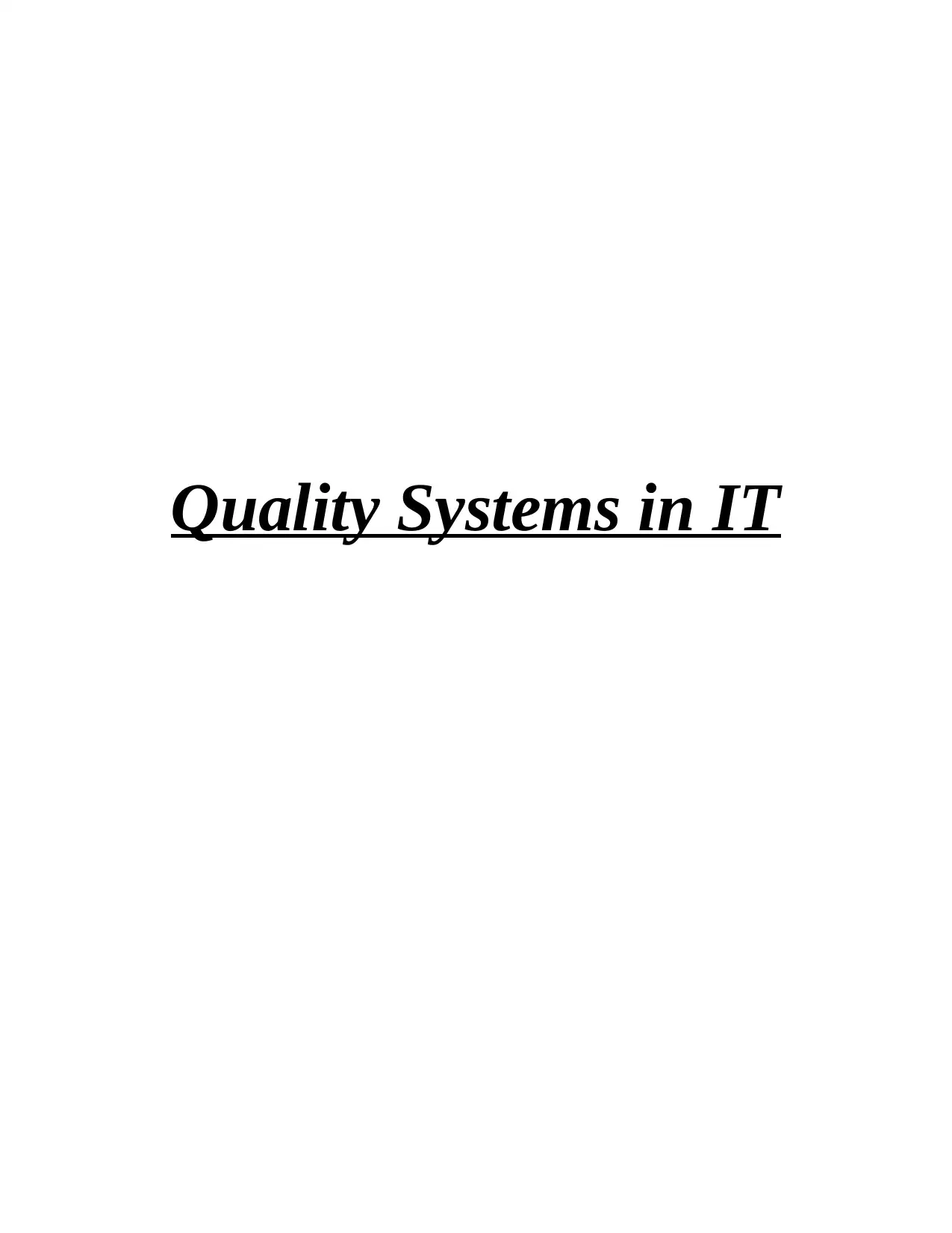
Quality Systems in IT
Paraphrase This Document
Need a fresh take? Get an instant paraphrase of this document with our AI Paraphraser
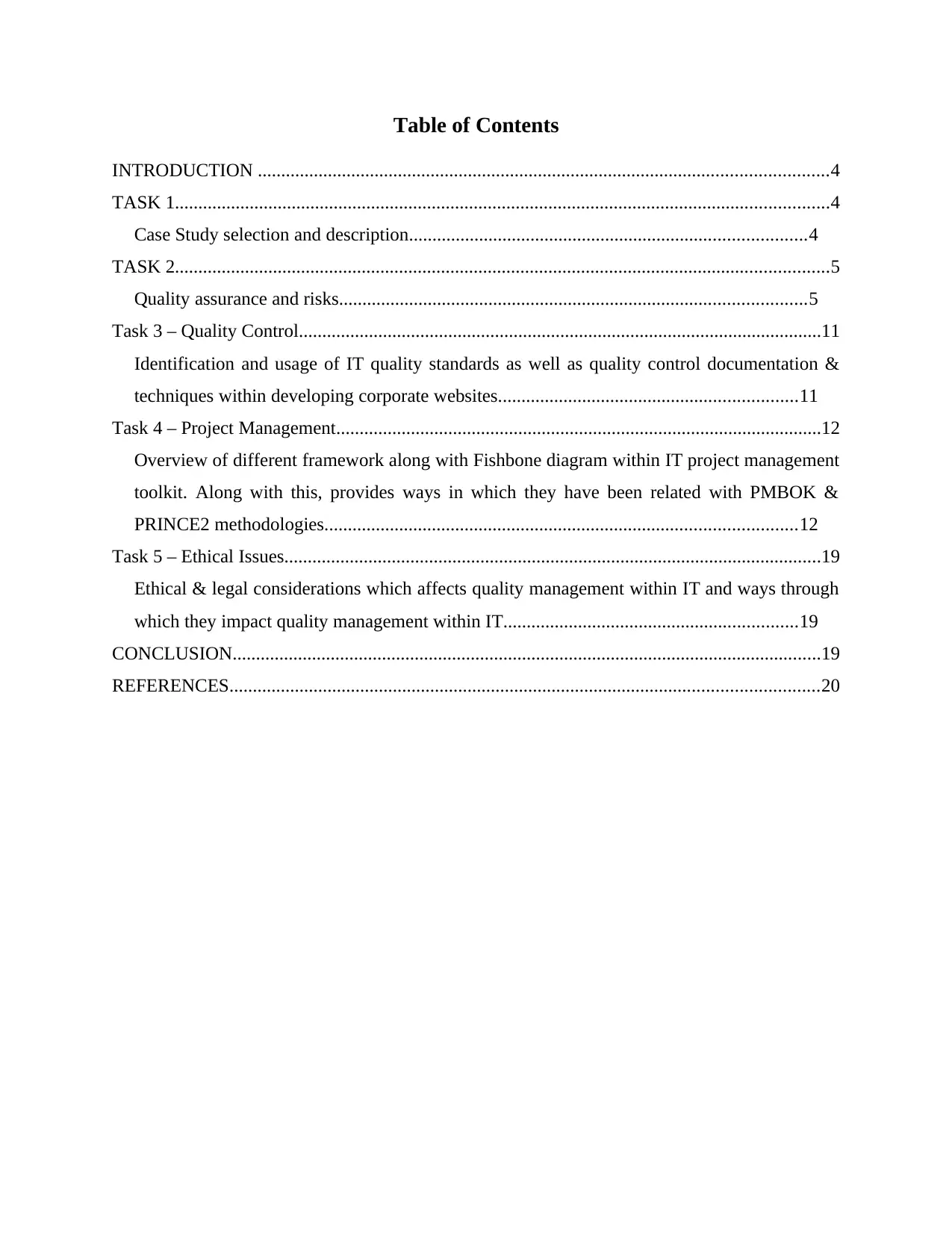
Table of Contents
INTRODUCTION ..........................................................................................................................4
TASK 1............................................................................................................................................4
Case Study selection and description.....................................................................................4
TASK 2............................................................................................................................................5
Quality assurance and risks....................................................................................................5
Task 3 – Quality Control................................................................................................................11
Identification and usage of IT quality standards as well as quality control documentation &
techniques within developing corporate websites................................................................11
Task 4 – Project Management........................................................................................................12
Overview of different framework along with Fishbone diagram within IT project management
toolkit. Along with this, provides ways in which they have been related with PMBOK &
PRINCE2 methodologies.....................................................................................................12
Task 5 – Ethical Issues...................................................................................................................19
Ethical & legal considerations which affects quality management within IT and ways through
which they impact quality management within IT...............................................................19
CONCLUSION..............................................................................................................................19
REFERENCES..............................................................................................................................20
INTRODUCTION ..........................................................................................................................4
TASK 1............................................................................................................................................4
Case Study selection and description.....................................................................................4
TASK 2............................................................................................................................................5
Quality assurance and risks....................................................................................................5
Task 3 – Quality Control................................................................................................................11
Identification and usage of IT quality standards as well as quality control documentation &
techniques within developing corporate websites................................................................11
Task 4 – Project Management........................................................................................................12
Overview of different framework along with Fishbone diagram within IT project management
toolkit. Along with this, provides ways in which they have been related with PMBOK &
PRINCE2 methodologies.....................................................................................................12
Task 5 – Ethical Issues...................................................................................................................19
Ethical & legal considerations which affects quality management within IT and ways through
which they impact quality management within IT...............................................................19
CONCLUSION..............................................................................................................................19
REFERENCES..............................................................................................................................20

⊘ This is a preview!⊘
Do you want full access?
Subscribe today to unlock all pages.

Trusted by 1+ million students worldwide
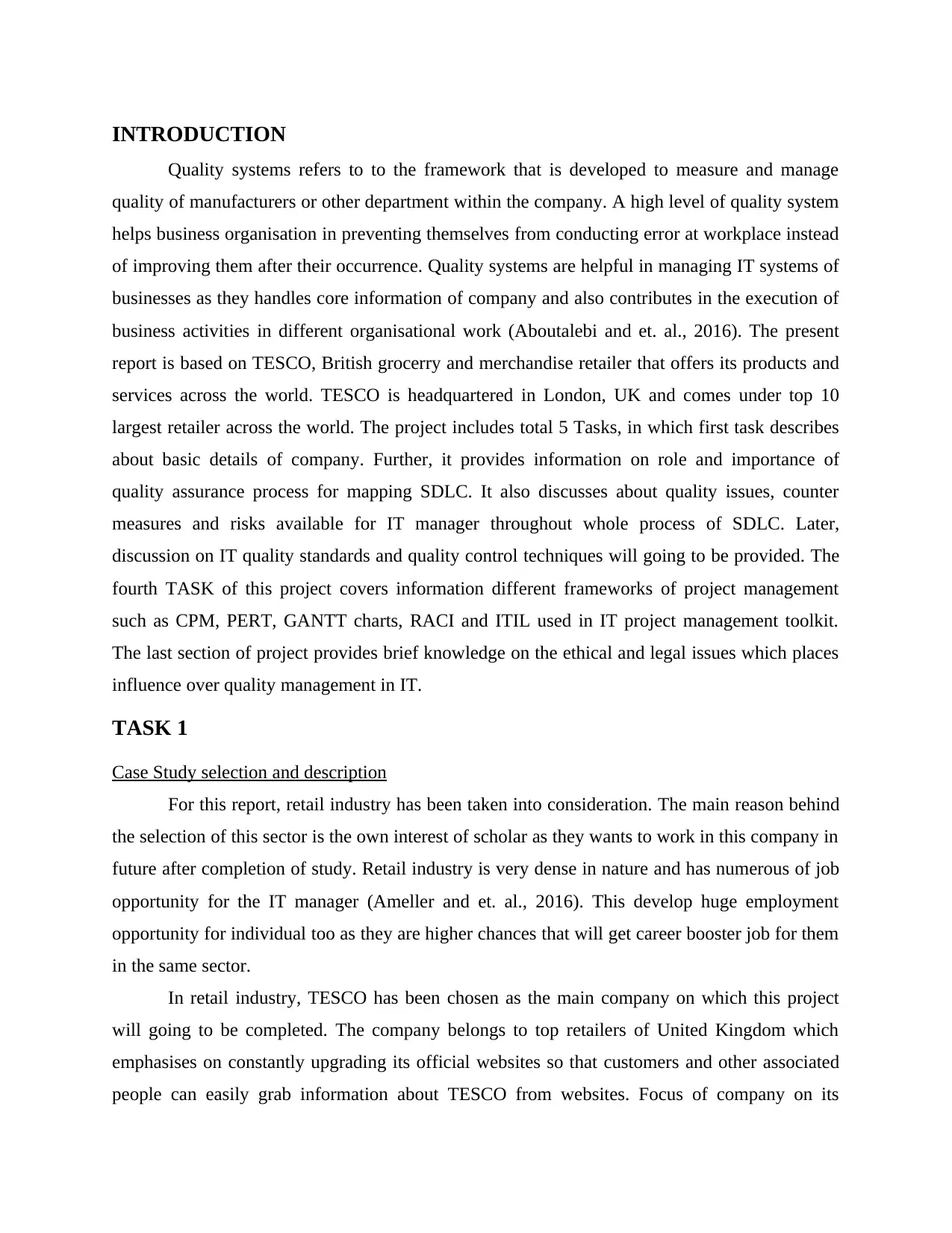
INTRODUCTION
Quality systems refers to to the framework that is developed to measure and manage
quality of manufacturers or other department within the company. A high level of quality system
helps business organisation in preventing themselves from conducting error at workplace instead
of improving them after their occurrence. Quality systems are helpful in managing IT systems of
businesses as they handles core information of company and also contributes in the execution of
business activities in different organisational work (Aboutalebi and et. al., 2016). The present
report is based on TESCO, British grocerry and merchandise retailer that offers its products and
services across the world. TESCO is headquartered in London, UK and comes under top 10
largest retailer across the world. The project includes total 5 Tasks, in which first task describes
about basic details of company. Further, it provides information on role and importance of
quality assurance process for mapping SDLC. It also discusses about quality issues, counter
measures and risks available for IT manager throughout whole process of SDLC. Later,
discussion on IT quality standards and quality control techniques will going to be provided. The
fourth TASK of this project covers information different frameworks of project management
such as CPM, PERT, GANTT charts, RACI and ITIL used in IT project management toolkit.
The last section of project provides brief knowledge on the ethical and legal issues which places
influence over quality management in IT.
TASK 1
Case Study selection and description
For this report, retail industry has been taken into consideration. The main reason behind
the selection of this sector is the own interest of scholar as they wants to work in this company in
future after completion of study. Retail industry is very dense in nature and has numerous of job
opportunity for the IT manager (Ameller and et. al., 2016). This develop huge employment
opportunity for individual too as they are higher chances that will get career booster job for them
in the same sector.
In retail industry, TESCO has been chosen as the main company on which this project
will going to be completed. The company belongs to top retailers of United Kingdom which
emphasises on constantly upgrading its official websites so that customers and other associated
people can easily grab information about TESCO from websites. Focus of company on its
Quality systems refers to to the framework that is developed to measure and manage
quality of manufacturers or other department within the company. A high level of quality system
helps business organisation in preventing themselves from conducting error at workplace instead
of improving them after their occurrence. Quality systems are helpful in managing IT systems of
businesses as they handles core information of company and also contributes in the execution of
business activities in different organisational work (Aboutalebi and et. al., 2016). The present
report is based on TESCO, British grocerry and merchandise retailer that offers its products and
services across the world. TESCO is headquartered in London, UK and comes under top 10
largest retailer across the world. The project includes total 5 Tasks, in which first task describes
about basic details of company. Further, it provides information on role and importance of
quality assurance process for mapping SDLC. It also discusses about quality issues, counter
measures and risks available for IT manager throughout whole process of SDLC. Later,
discussion on IT quality standards and quality control techniques will going to be provided. The
fourth TASK of this project covers information different frameworks of project management
such as CPM, PERT, GANTT charts, RACI and ITIL used in IT project management toolkit.
The last section of project provides brief knowledge on the ethical and legal issues which places
influence over quality management in IT.
TASK 1
Case Study selection and description
For this report, retail industry has been taken into consideration. The main reason behind
the selection of this sector is the own interest of scholar as they wants to work in this company in
future after completion of study. Retail industry is very dense in nature and has numerous of job
opportunity for the IT manager (Ameller and et. al., 2016). This develop huge employment
opportunity for individual too as they are higher chances that will get career booster job for them
in the same sector.
In retail industry, TESCO has been chosen as the main company on which this project
will going to be completed. The company belongs to top retailers of United Kingdom which
emphasises on constantly upgrading its official websites so that customers and other associated
people can easily grab information about TESCO from websites. Focus of company on its
Paraphrase This Document
Need a fresh take? Get an instant paraphrase of this document with our AI Paraphraser
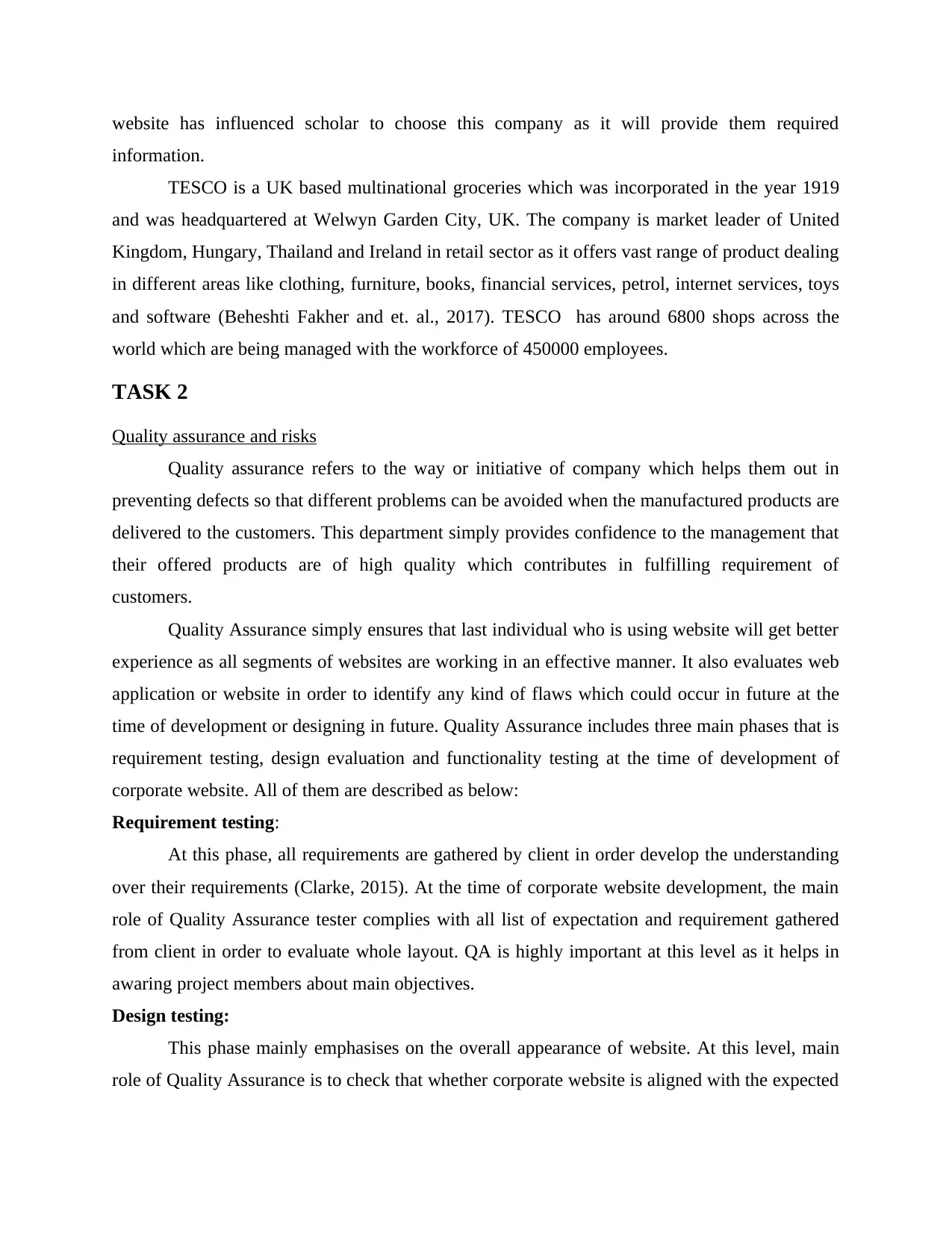
website has influenced scholar to choose this company as it will provide them required
information.
TESCO is a UK based multinational groceries which was incorporated in the year 1919
and was headquartered at Welwyn Garden City, UK. The company is market leader of United
Kingdom, Hungary, Thailand and Ireland in retail sector as it offers vast range of product dealing
in different areas like clothing, furniture, books, financial services, petrol, internet services, toys
and software (Beheshti Fakher and et. al., 2017). TESCO has around 6800 shops across the
world which are being managed with the workforce of 450000 employees.
TASK 2
Quality assurance and risks
Quality assurance refers to the way or initiative of company which helps them out in
preventing defects so that different problems can be avoided when the manufactured products are
delivered to the customers. This department simply provides confidence to the management that
their offered products are of high quality which contributes in fulfilling requirement of
customers.
Quality Assurance simply ensures that last individual who is using website will get better
experience as all segments of websites are working in an effective manner. It also evaluates web
application or website in order to identify any kind of flaws which could occur in future at the
time of development or designing in future. Quality Assurance includes three main phases that is
requirement testing, design evaluation and functionality testing at the time of development of
corporate website. All of them are described as below:
Requirement testing:
At this phase, all requirements are gathered by client in order develop the understanding
over their requirements (Clarke, 2015). At the time of corporate website development, the main
role of Quality Assurance tester complies with all list of expectation and requirement gathered
from client in order to evaluate whole layout. QA is highly important at this level as it helps in
awaring project members about main objectives.
Design testing:
This phase mainly emphasises on the overall appearance of website. At this level, main
role of Quality Assurance is to check that whether corporate website is aligned with the expected
information.
TESCO is a UK based multinational groceries which was incorporated in the year 1919
and was headquartered at Welwyn Garden City, UK. The company is market leader of United
Kingdom, Hungary, Thailand and Ireland in retail sector as it offers vast range of product dealing
in different areas like clothing, furniture, books, financial services, petrol, internet services, toys
and software (Beheshti Fakher and et. al., 2017). TESCO has around 6800 shops across the
world which are being managed with the workforce of 450000 employees.
TASK 2
Quality assurance and risks
Quality assurance refers to the way or initiative of company which helps them out in
preventing defects so that different problems can be avoided when the manufactured products are
delivered to the customers. This department simply provides confidence to the management that
their offered products are of high quality which contributes in fulfilling requirement of
customers.
Quality Assurance simply ensures that last individual who is using website will get better
experience as all segments of websites are working in an effective manner. It also evaluates web
application or website in order to identify any kind of flaws which could occur in future at the
time of development or designing in future. Quality Assurance includes three main phases that is
requirement testing, design evaluation and functionality testing at the time of development of
corporate website. All of them are described as below:
Requirement testing:
At this phase, all requirements are gathered by client in order develop the understanding
over their requirements (Clarke, 2015). At the time of corporate website development, the main
role of Quality Assurance tester complies with all list of expectation and requirement gathered
from client in order to evaluate whole layout. QA is highly important at this level as it helps in
awaring project members about main objectives.
Design testing:
This phase mainly emphasises on the overall appearance of website. At this level, main
role of Quality Assurance is to check that whether corporate website is aligned with the expected
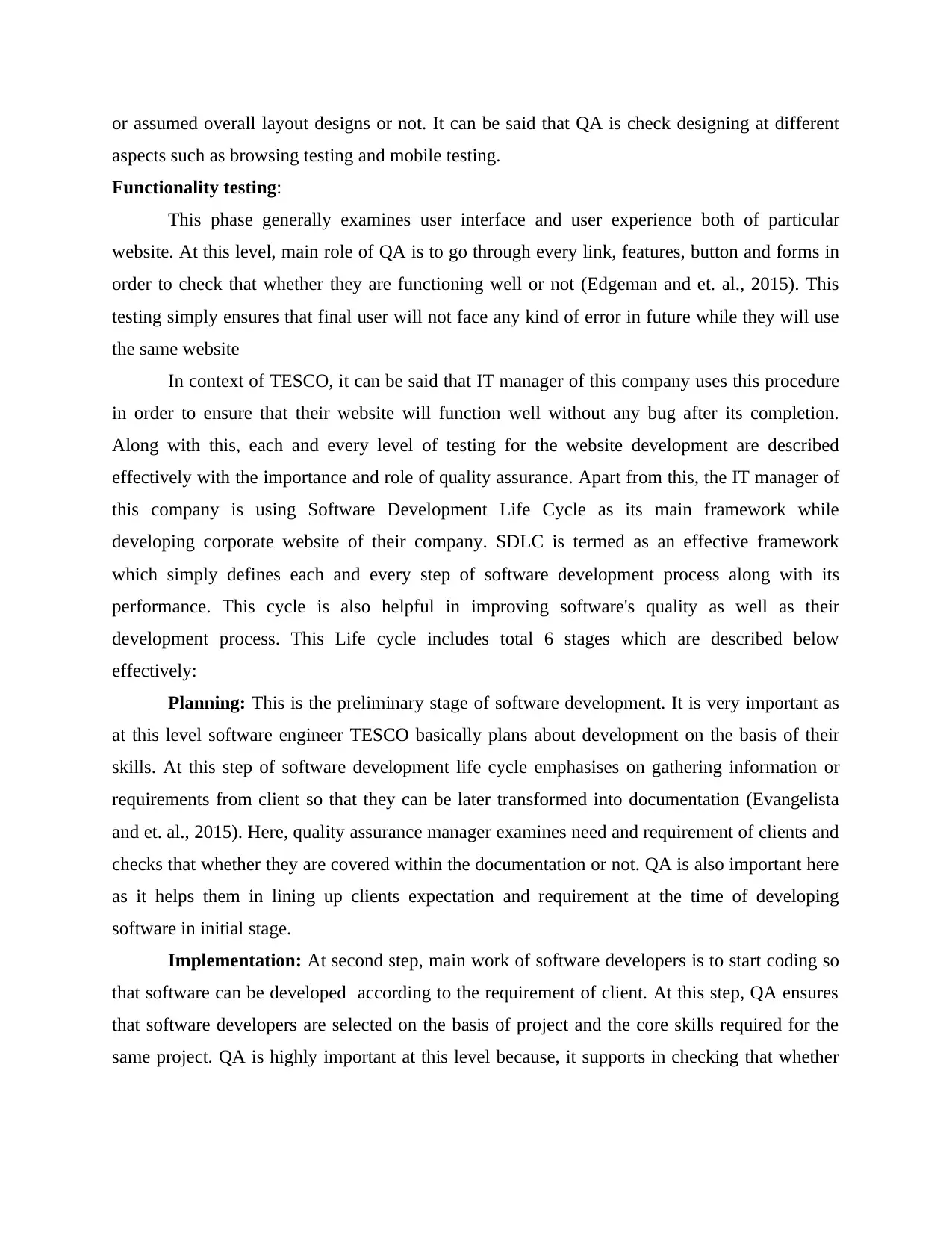
or assumed overall layout designs or not. It can be said that QA is check designing at different
aspects such as browsing testing and mobile testing.
Functionality testing:
This phase generally examines user interface and user experience both of particular
website. At this level, main role of QA is to go through every link, features, button and forms in
order to check that whether they are functioning well or not (Edgeman and et. al., 2015). This
testing simply ensures that final user will not face any kind of error in future while they will use
the same website
In context of TESCO, it can be said that IT manager of this company uses this procedure
in order to ensure that their website will function well without any bug after its completion.
Along with this, each and every level of testing for the website development are described
effectively with the importance and role of quality assurance. Apart from this, the IT manager of
this company is using Software Development Life Cycle as its main framework while
developing corporate website of their company. SDLC is termed as an effective framework
which simply defines each and every step of software development process along with its
performance. This cycle is also helpful in improving software's quality as well as their
development process. This Life cycle includes total 6 stages which are described below
effectively:
Planning: This is the preliminary stage of software development. It is very important as
at this level software engineer TESCO basically plans about development on the basis of their
skills. At this step of software development life cycle emphasises on gathering information or
requirements from client so that they can be later transformed into documentation (Evangelista
and et. al., 2015). Here, quality assurance manager examines need and requirement of clients and
checks that whether they are covered within the documentation or not. QA is also important here
as it helps them in lining up clients expectation and requirement at the time of developing
software in initial stage.
Implementation: At second step, main work of software developers is to start coding so
that software can be developed according to the requirement of client. At this step, QA ensures
that software developers are selected on the basis of project and the core skills required for the
same project. QA is highly important at this level because, it supports in checking that whether
aspects such as browsing testing and mobile testing.
Functionality testing:
This phase generally examines user interface and user experience both of particular
website. At this level, main role of QA is to go through every link, features, button and forms in
order to check that whether they are functioning well or not (Edgeman and et. al., 2015). This
testing simply ensures that final user will not face any kind of error in future while they will use
the same website
In context of TESCO, it can be said that IT manager of this company uses this procedure
in order to ensure that their website will function well without any bug after its completion.
Along with this, each and every level of testing for the website development are described
effectively with the importance and role of quality assurance. Apart from this, the IT manager of
this company is using Software Development Life Cycle as its main framework while
developing corporate website of their company. SDLC is termed as an effective framework
which simply defines each and every step of software development process along with its
performance. This cycle is also helpful in improving software's quality as well as their
development process. This Life cycle includes total 6 stages which are described below
effectively:
Planning: This is the preliminary stage of software development. It is very important as
at this level software engineer TESCO basically plans about development on the basis of their
skills. At this step of software development life cycle emphasises on gathering information or
requirements from client so that they can be later transformed into documentation (Evangelista
and et. al., 2015). Here, quality assurance manager examines need and requirement of clients and
checks that whether they are covered within the documentation or not. QA is also important here
as it helps them in lining up clients expectation and requirement at the time of developing
software in initial stage.
Implementation: At second step, main work of software developers is to start coding so
that software can be developed according to the requirement of client. At this step, QA ensures
that software developers are selected on the basis of project and the core skills required for the
same project. QA is highly important at this level because, it supports in checking that whether
⊘ This is a preview!⊘
Do you want full access?
Subscribe today to unlock all pages.

Trusted by 1+ million students worldwide
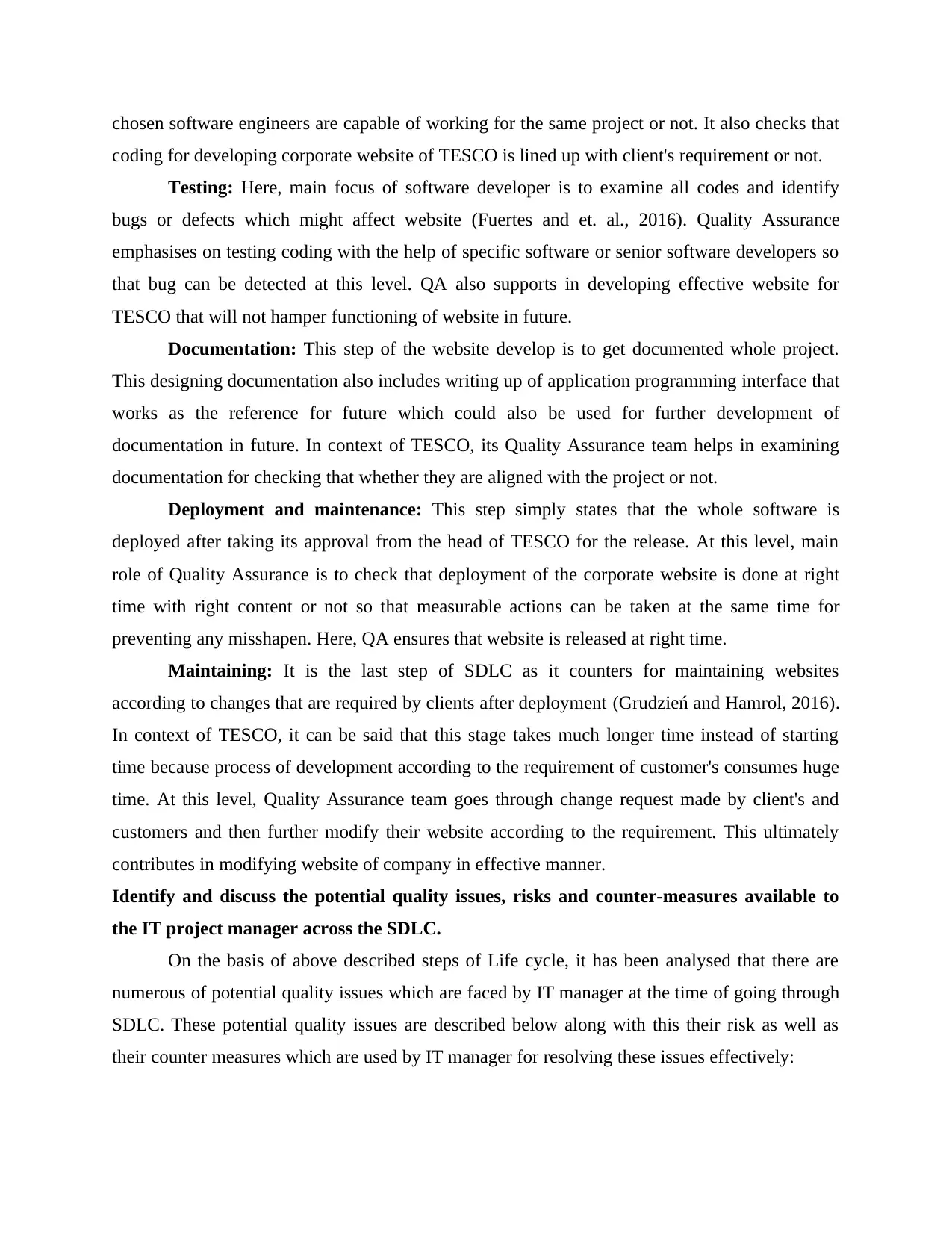
chosen software engineers are capable of working for the same project or not. It also checks that
coding for developing corporate website of TESCO is lined up with client's requirement or not.
Testing: Here, main focus of software developer is to examine all codes and identify
bugs or defects which might affect website (Fuertes and et. al., 2016). Quality Assurance
emphasises on testing coding with the help of specific software or senior software developers so
that bug can be detected at this level. QA also supports in developing effective website for
TESCO that will not hamper functioning of website in future.
Documentation: This step of the website develop is to get documented whole project.
This designing documentation also includes writing up of application programming interface that
works as the reference for future which could also be used for further development of
documentation in future. In context of TESCO, its Quality Assurance team helps in examining
documentation for checking that whether they are aligned with the project or not.
Deployment and maintenance: This step simply states that the whole software is
deployed after taking its approval from the head of TESCO for the release. At this level, main
role of Quality Assurance is to check that deployment of the corporate website is done at right
time with right content or not so that measurable actions can be taken at the same time for
preventing any misshapen. Here, QA ensures that website is released at right time.
Maintaining: It is the last step of SDLC as it counters for maintaining websites
according to changes that are required by clients after deployment (Grudzień and Hamrol, 2016).
In context of TESCO, it can be said that this stage takes much longer time instead of starting
time because process of development according to the requirement of customer's consumes huge
time. At this level, Quality Assurance team goes through change request made by client's and
customers and then further modify their website according to the requirement. This ultimately
contributes in modifying website of company in effective manner.
Identify and discuss the potential quality issues, risks and counter-measures available to
the IT project manager across the SDLC.
On the basis of above described steps of Life cycle, it has been analysed that there are
numerous of potential quality issues which are faced by IT manager at the time of going through
SDLC. These potential quality issues are described below along with this their risk as well as
their counter measures which are used by IT manager for resolving these issues effectively:
coding for developing corporate website of TESCO is lined up with client's requirement or not.
Testing: Here, main focus of software developer is to examine all codes and identify
bugs or defects which might affect website (Fuertes and et. al., 2016). Quality Assurance
emphasises on testing coding with the help of specific software or senior software developers so
that bug can be detected at this level. QA also supports in developing effective website for
TESCO that will not hamper functioning of website in future.
Documentation: This step of the website develop is to get documented whole project.
This designing documentation also includes writing up of application programming interface that
works as the reference for future which could also be used for further development of
documentation in future. In context of TESCO, its Quality Assurance team helps in examining
documentation for checking that whether they are aligned with the project or not.
Deployment and maintenance: This step simply states that the whole software is
deployed after taking its approval from the head of TESCO for the release. At this level, main
role of Quality Assurance is to check that deployment of the corporate website is done at right
time with right content or not so that measurable actions can be taken at the same time for
preventing any misshapen. Here, QA ensures that website is released at right time.
Maintaining: It is the last step of SDLC as it counters for maintaining websites
according to changes that are required by clients after deployment (Grudzień and Hamrol, 2016).
In context of TESCO, it can be said that this stage takes much longer time instead of starting
time because process of development according to the requirement of customer's consumes huge
time. At this level, Quality Assurance team goes through change request made by client's and
customers and then further modify their website according to the requirement. This ultimately
contributes in modifying website of company in effective manner.
Identify and discuss the potential quality issues, risks and counter-measures available to
the IT project manager across the SDLC.
On the basis of above described steps of Life cycle, it has been analysed that there are
numerous of potential quality issues which are faced by IT manager at the time of going through
SDLC. These potential quality issues are described below along with this their risk as well as
their counter measures which are used by IT manager for resolving these issues effectively:
Paraphrase This Document
Need a fresh take? Get an instant paraphrase of this document with our AI Paraphraser
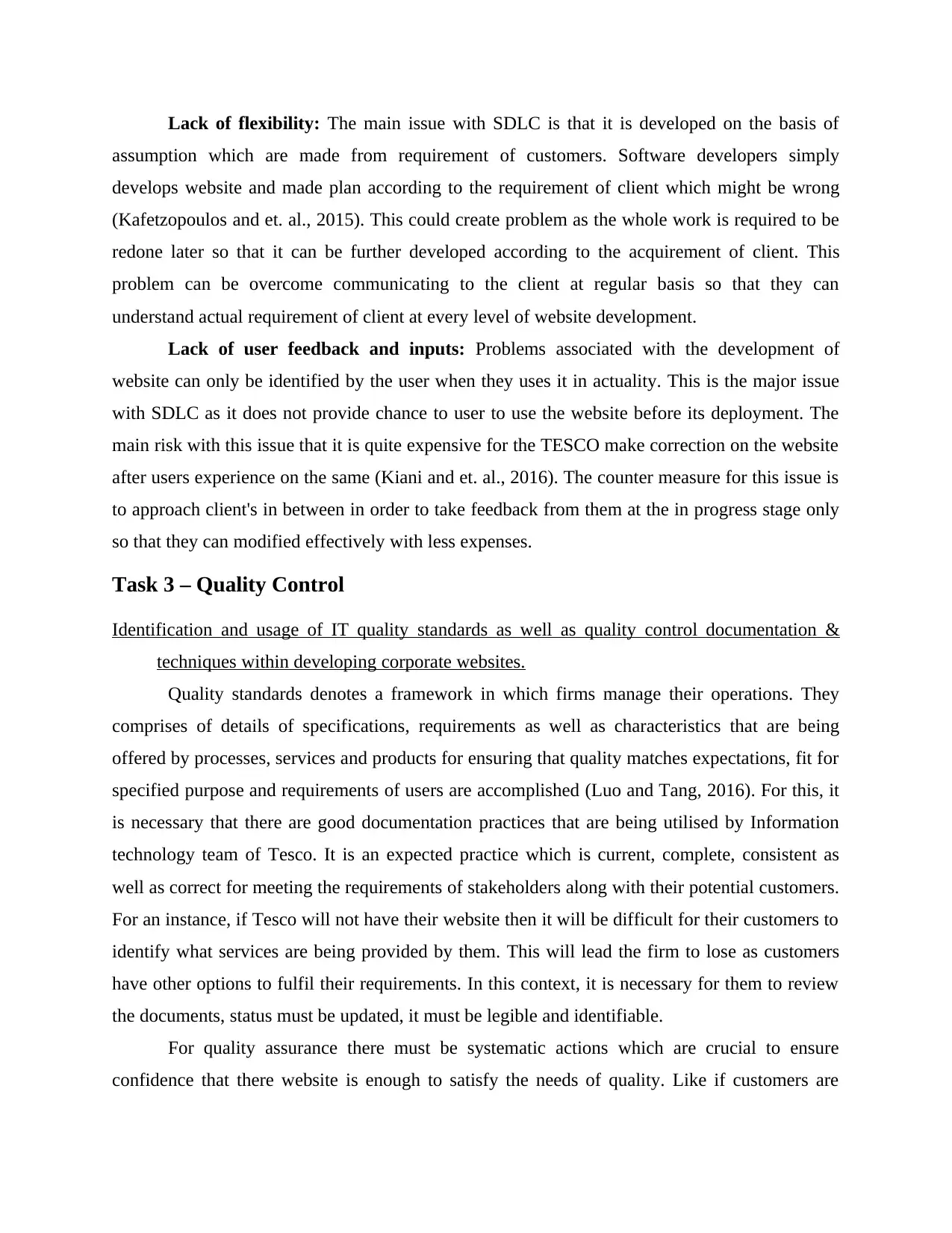
Lack of flexibility: The main issue with SDLC is that it is developed on the basis of
assumption which are made from requirement of customers. Software developers simply
develops website and made plan according to the requirement of client which might be wrong
(Kafetzopoulos and et. al., 2015). This could create problem as the whole work is required to be
redone later so that it can be further developed according to the acquirement of client. This
problem can be overcome communicating to the client at regular basis so that they can
understand actual requirement of client at every level of website development.
Lack of user feedback and inputs: Problems associated with the development of
website can only be identified by the user when they uses it in actuality. This is the major issue
with SDLC as it does not provide chance to user to use the website before its deployment. The
main risk with this issue that it is quite expensive for the TESCO make correction on the website
after users experience on the same (Kiani and et. al., 2016). The counter measure for this issue is
to approach client's in between in order to take feedback from them at the in progress stage only
so that they can modified effectively with less expenses.
Task 3 – Quality Control
Identification and usage of IT quality standards as well as quality control documentation &
techniques within developing corporate websites.
Quality standards denotes a framework in which firms manage their operations. They
comprises of details of specifications, requirements as well as characteristics that are being
offered by processes, services and products for ensuring that quality matches expectations, fit for
specified purpose and requirements of users are accomplished (Luo and Tang, 2016). For this, it
is necessary that there are good documentation practices that are being utilised by Information
technology team of Tesco. It is an expected practice which is current, complete, consistent as
well as correct for meeting the requirements of stakeholders along with their potential customers.
For an instance, if Tesco will not have their website then it will be difficult for their customers to
identify what services are being provided by them. This will lead the firm to lose as customers
have other options to fulfil their requirements. In this context, it is necessary for them to review
the documents, status must be updated, it must be legible and identifiable.
For quality assurance there must be systematic actions which are crucial to ensure
confidence that there website is enough to satisfy the needs of quality. Like if customers are
assumption which are made from requirement of customers. Software developers simply
develops website and made plan according to the requirement of client which might be wrong
(Kafetzopoulos and et. al., 2015). This could create problem as the whole work is required to be
redone later so that it can be further developed according to the acquirement of client. This
problem can be overcome communicating to the client at regular basis so that they can
understand actual requirement of client at every level of website development.
Lack of user feedback and inputs: Problems associated with the development of
website can only be identified by the user when they uses it in actuality. This is the major issue
with SDLC as it does not provide chance to user to use the website before its deployment. The
main risk with this issue that it is quite expensive for the TESCO make correction on the website
after users experience on the same (Kiani and et. al., 2016). The counter measure for this issue is
to approach client's in between in order to take feedback from them at the in progress stage only
so that they can modified effectively with less expenses.
Task 3 – Quality Control
Identification and usage of IT quality standards as well as quality control documentation &
techniques within developing corporate websites.
Quality standards denotes a framework in which firms manage their operations. They
comprises of details of specifications, requirements as well as characteristics that are being
offered by processes, services and products for ensuring that quality matches expectations, fit for
specified purpose and requirements of users are accomplished (Luo and Tang, 2016). For this, it
is necessary that there are good documentation practices that are being utilised by Information
technology team of Tesco. It is an expected practice which is current, complete, consistent as
well as correct for meeting the requirements of stakeholders along with their potential customers.
For an instance, if Tesco will not have their website then it will be difficult for their customers to
identify what services are being provided by them. This will lead the firm to lose as customers
have other options to fulfil their requirements. In this context, it is necessary for them to review
the documents, status must be updated, it must be legible and identifiable.
For quality assurance there must be systematic actions which are crucial to ensure
confidence that there website is enough to satisfy the needs of quality. Like if customers are
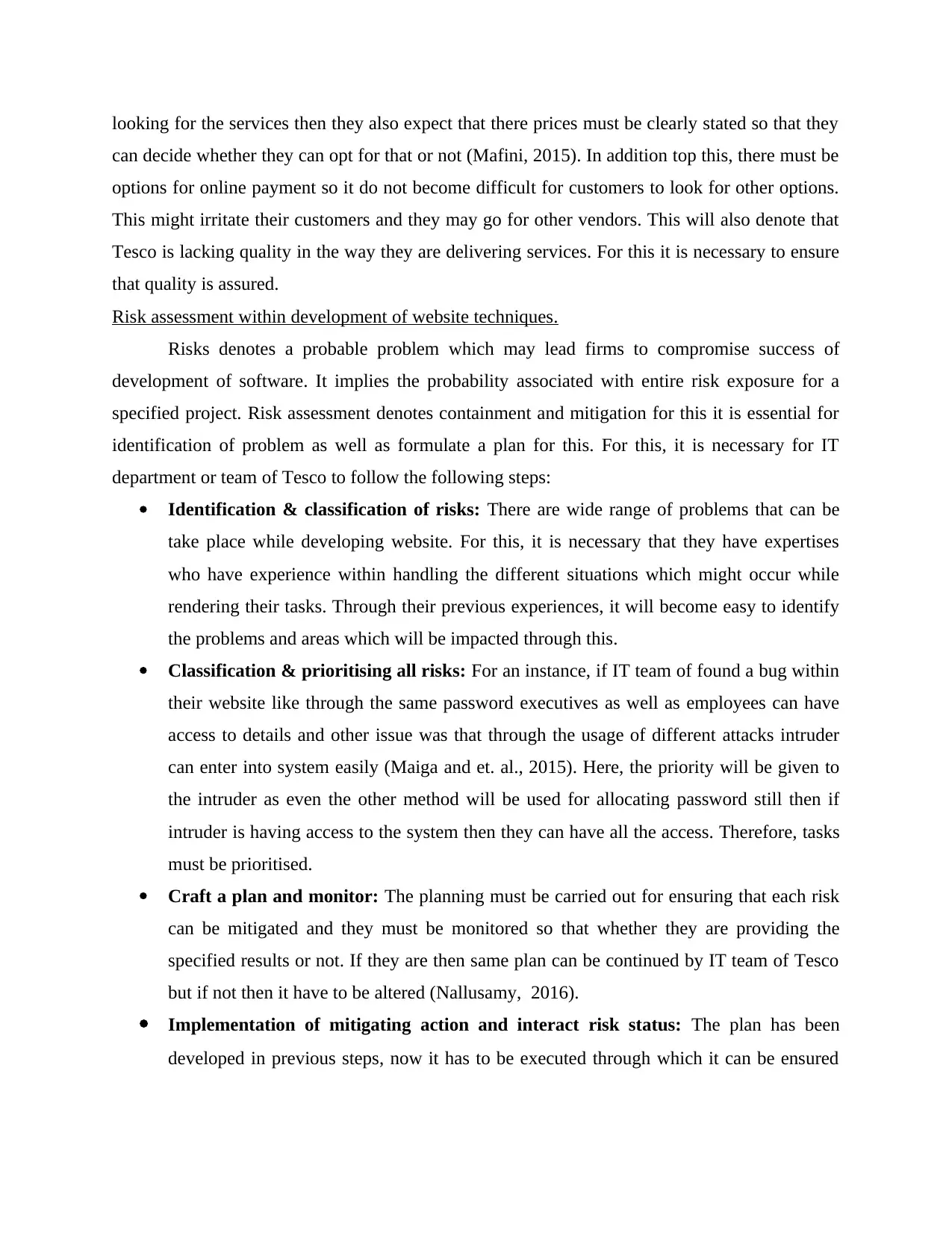
looking for the services then they also expect that there prices must be clearly stated so that they
can decide whether they can opt for that or not (Mafini, 2015). In addition top this, there must be
options for online payment so it do not become difficult for customers to look for other options.
This might irritate their customers and they may go for other vendors. This will also denote that
Tesco is lacking quality in the way they are delivering services. For this it is necessary to ensure
that quality is assured.
Risk assessment within development of website techniques.
Risks denotes a probable problem which may lead firms to compromise success of
development of software. It implies the probability associated with entire risk exposure for a
specified project. Risk assessment denotes containment and mitigation for this it is essential for
identification of problem as well as formulate a plan for this. For this, it is necessary for IT
department or team of Tesco to follow the following steps:
Identification & classification of risks: There are wide range of problems that can be
take place while developing website. For this, it is necessary that they have expertises
who have experience within handling the different situations which might occur while
rendering their tasks. Through their previous experiences, it will become easy to identify
the problems and areas which will be impacted through this.
Classification & prioritising all risks: For an instance, if IT team of found a bug within
their website like through the same password executives as well as employees can have
access to details and other issue was that through the usage of different attacks intruder
can enter into system easily (Maiga and et. al., 2015). Here, the priority will be given to
the intruder as even the other method will be used for allocating password still then if
intruder is having access to the system then they can have all the access. Therefore, tasks
must be prioritised.
Craft a plan and monitor: The planning must be carried out for ensuring that each risk
can be mitigated and they must be monitored so that whether they are providing the
specified results or not. If they are then same plan can be continued by IT team of Tesco
but if not then it have to be altered (Nallusamy, 2016).
Implementation of mitigating action and interact risk status: The plan has been
developed in previous steps, now it has to be executed through which it can be ensured
can decide whether they can opt for that or not (Mafini, 2015). In addition top this, there must be
options for online payment so it do not become difficult for customers to look for other options.
This might irritate their customers and they may go for other vendors. This will also denote that
Tesco is lacking quality in the way they are delivering services. For this it is necessary to ensure
that quality is assured.
Risk assessment within development of website techniques.
Risks denotes a probable problem which may lead firms to compromise success of
development of software. It implies the probability associated with entire risk exposure for a
specified project. Risk assessment denotes containment and mitigation for this it is essential for
identification of problem as well as formulate a plan for this. For this, it is necessary for IT
department or team of Tesco to follow the following steps:
Identification & classification of risks: There are wide range of problems that can be
take place while developing website. For this, it is necessary that they have expertises
who have experience within handling the different situations which might occur while
rendering their tasks. Through their previous experiences, it will become easy to identify
the problems and areas which will be impacted through this.
Classification & prioritising all risks: For an instance, if IT team of found a bug within
their website like through the same password executives as well as employees can have
access to details and other issue was that through the usage of different attacks intruder
can enter into system easily (Maiga and et. al., 2015). Here, the priority will be given to
the intruder as even the other method will be used for allocating password still then if
intruder is having access to the system then they can have all the access. Therefore, tasks
must be prioritised.
Craft a plan and monitor: The planning must be carried out for ensuring that each risk
can be mitigated and they must be monitored so that whether they are providing the
specified results or not. If they are then same plan can be continued by IT team of Tesco
but if not then it have to be altered (Nallusamy, 2016).
Implementation of mitigating action and interact risk status: The plan has been
developed in previous steps, now it has to be executed through which it can be ensured
⊘ This is a preview!⊘
Do you want full access?
Subscribe today to unlock all pages.

Trusted by 1+ million students worldwide
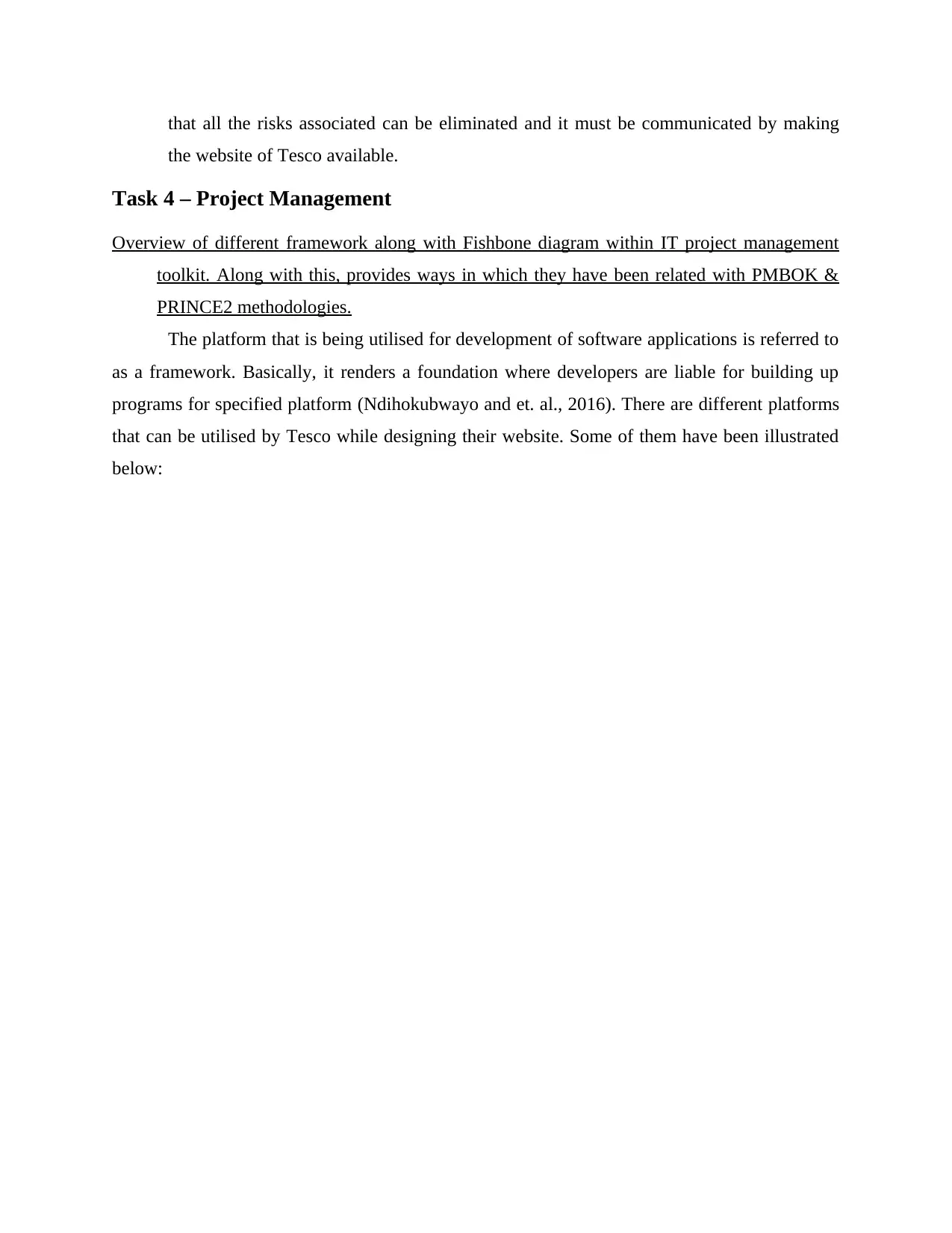
that all the risks associated can be eliminated and it must be communicated by making
the website of Tesco available.
Task 4 – Project Management
Overview of different framework along with Fishbone diagram within IT project management
toolkit. Along with this, provides ways in which they have been related with PMBOK &
PRINCE2 methodologies.
The platform that is being utilised for development of software applications is referred to
as a framework. Basically, it renders a foundation where developers are liable for building up
programs for specified platform (Ndihokubwayo and et. al., 2016). There are different platforms
that can be utilised by Tesco while designing their website. Some of them have been illustrated
below:
the website of Tesco available.
Task 4 – Project Management
Overview of different framework along with Fishbone diagram within IT project management
toolkit. Along with this, provides ways in which they have been related with PMBOK &
PRINCE2 methodologies.
The platform that is being utilised for development of software applications is referred to
as a framework. Basically, it renders a foundation where developers are liable for building up
programs for specified platform (Ndihokubwayo and et. al., 2016). There are different platforms
that can be utilised by Tesco while designing their website. Some of them have been illustrated
below:
Paraphrase This Document
Need a fresh take? Get an instant paraphrase of this document with our AI Paraphraser
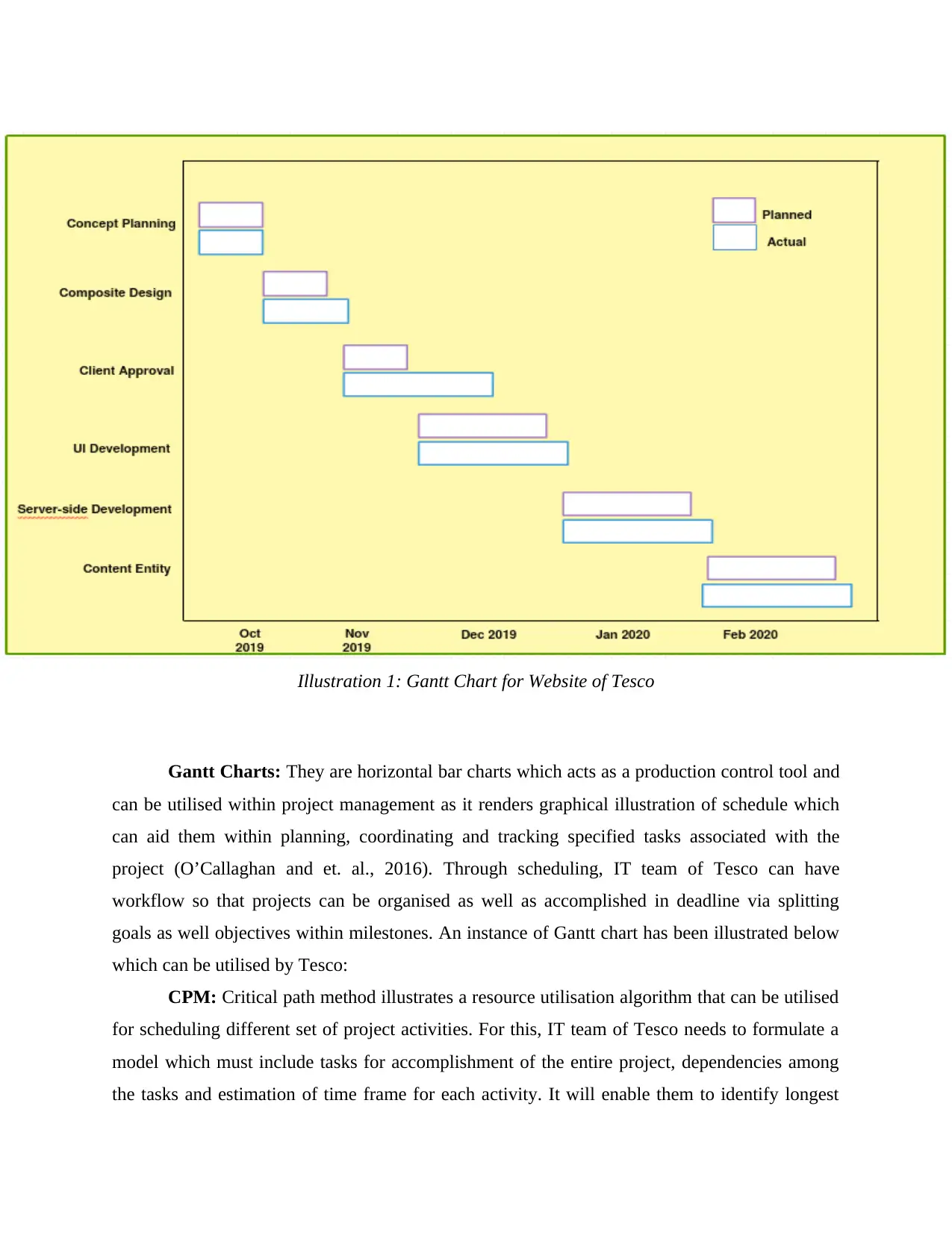
Gantt Charts: They are horizontal bar charts which acts as a production control tool and
can be utilised within project management as it renders graphical illustration of schedule which
can aid them within planning, coordinating and tracking specified tasks associated with the
project (O’Callaghan and et. al., 2016). Through scheduling, IT team of Tesco can have
workflow so that projects can be organised as well as accomplished in deadline via splitting
goals as well objectives within milestones. An instance of Gantt chart has been illustrated below
which can be utilised by Tesco:
CPM: Critical path method illustrates a resource utilisation algorithm that can be utilised
for scheduling different set of project activities. For this, IT team of Tesco needs to formulate a
model which must include tasks for accomplishment of the entire project, dependencies among
the tasks and estimation of time frame for each activity. It will enable them to identify longest
Illustration 1: Gantt Chart for Website of Tesco
can be utilised within project management as it renders graphical illustration of schedule which
can aid them within planning, coordinating and tracking specified tasks associated with the
project (O’Callaghan and et. al., 2016). Through scheduling, IT team of Tesco can have
workflow so that projects can be organised as well as accomplished in deadline via splitting
goals as well objectives within milestones. An instance of Gantt chart has been illustrated below
which can be utilised by Tesco:
CPM: Critical path method illustrates a resource utilisation algorithm that can be utilised
for scheduling different set of project activities. For this, IT team of Tesco needs to formulate a
model which must include tasks for accomplishment of the entire project, dependencies among
the tasks and estimation of time frame for each activity. It will enable them to identify longest
Illustration 1: Gantt Chart for Website of Tesco
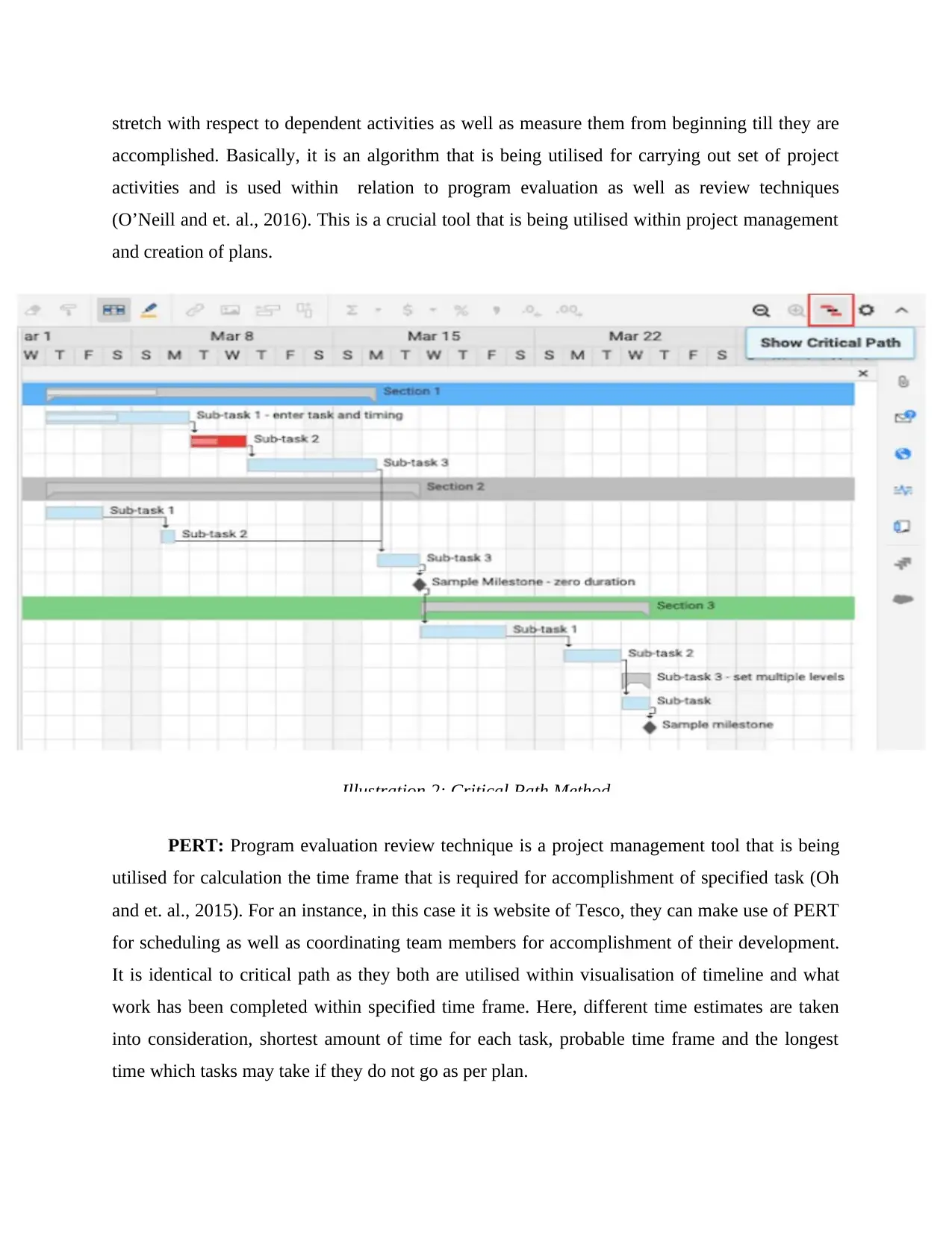
stretch with respect to dependent activities as well as measure them from beginning till they are
accomplished. Basically, it is an algorithm that is being utilised for carrying out set of project
activities and is used within relation to program evaluation as well as review techniques
(O’Neill and et. al., 2016). This is a crucial tool that is being utilised within project management
and creation of plans.
PERT: Program evaluation review technique is a project management tool that is being
utilised for calculation the time frame that is required for accomplishment of specified task (Oh
and et. al., 2015). For an instance, in this case it is website of Tesco, they can make use of PERT
for scheduling as well as coordinating team members for accomplishment of their development.
It is identical to critical path as they both are utilised within visualisation of timeline and what
work has been completed within specified time frame. Here, different time estimates are taken
into consideration, shortest amount of time for each task, probable time frame and the longest
time which tasks may take if they do not go as per plan.
Illustration 2: Critical Path Method
accomplished. Basically, it is an algorithm that is being utilised for carrying out set of project
activities and is used within relation to program evaluation as well as review techniques
(O’Neill and et. al., 2016). This is a crucial tool that is being utilised within project management
and creation of plans.
PERT: Program evaluation review technique is a project management tool that is being
utilised for calculation the time frame that is required for accomplishment of specified task (Oh
and et. al., 2015). For an instance, in this case it is website of Tesco, they can make use of PERT
for scheduling as well as coordinating team members for accomplishment of their development.
It is identical to critical path as they both are utilised within visualisation of timeline and what
work has been completed within specified time frame. Here, different time estimates are taken
into consideration, shortest amount of time for each task, probable time frame and the longest
time which tasks may take if they do not go as per plan.
Illustration 2: Critical Path Method
⊘ This is a preview!⊘
Do you want full access?
Subscribe today to unlock all pages.

Trusted by 1+ million students worldwide
1 out of 19
Related Documents
Your All-in-One AI-Powered Toolkit for Academic Success.
+13062052269
info@desklib.com
Available 24*7 on WhatsApp / Email
![[object Object]](/_next/static/media/star-bottom.7253800d.svg)
Unlock your academic potential
Copyright © 2020–2025 A2Z Services. All Rights Reserved. Developed and managed by ZUCOL.




